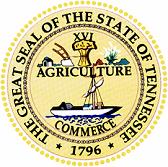 |
 |
 |
Forrest's West Tennessee Raid - December 18-31, 1862
kiosk beside the North Loop Walking Trail. It is located 340 feet from the start of the trail just before where the trail splits. The marker is at Tour Stop 1 (Parkers Crossroads City Park), Wildersville,
TN ,
USA
Latitude & Longitude:
35° 47' 47.0904",
,-88° 23' 28.46544"
|
|

Tennessee State
Historical Marker
|
| |
| |
On December 11, 1862 Forrest's new command, now woefully lacking in arms and ammunition, left Columbia to commence the raid that if successful, may force the enemy to retire from Mississippi. The brigade reached the Tennessee River at Clifton four days later. The two-day crossing was made 50 men at a time under cover of darkness. Even so, it did not go unnoticed and, more to the point, was not unexpected. In fact, the day Forrest left Columbia, Grant received a telegram from Nashville to tell the authorities along the (rail)road to look out for Forrest.
December 18 - The brigade successfully engages Union troops near Lexington Colonel Robert Ingersoll and most of his men are captured. Lieutenant John Morton is given command of the two three-inch Rodman cannon that are captured.
December 19 - Forrest attacks at Salem Cemetery, drawing attention to Jackson, as planned. Meanwhile, Dibrell attacks the stockade at Carroll Station, burning the stockade and taking a large quantity of ammunition and other supplies. Russell and Cox hit the Mobile & Ohio Railroad burning bridges and cutting the telegraph, and then ride west to the Mississippi Central Railroad where they burn ties and twist rails into Forrest neckties.
December 20 - Dibrell. meeting with unanticipated Union reinforcements, fails to take the Deer Fork Stockade but Starnes encounters little resistance at Humboldt. The stockade, depot, and railroad bridge are burned. Forrest attacks Trenton and captures several hundred horses and mules, thirteen wagons and ambulances, seven caissons, 200 artillery rounds, 400,000 rounds of small arms ammunition, and 100,000 rations.
December 21 - The stockades at Rutherford Station and Kenton Station are captured and burned. A railroad bridge is burned and the track heavily damaged.
December 22 - Work parties begin to systematically wreck a 50-mile section of track running through the Obion bottoms, an undertaking that takes three days.
December 23 - Forrest and 400 men take Union City. The Federals, believing they are greatly outnumbered, surrender without a shot being fired.
December 24 - A 40-man detachment rides into Kentucky, burning a bridge near Moscow. General Thomas Davies in Columbus believes an attack by Forrest is imminent. Forrest writes to Bragg, We have made a clean sweep of the Federals and the (rail)roads north of Jackson.
December 25 - The brigade destroys bridges and trestles along the Nashville & Northwestern Railroad as they ride toward the Tennessee River.
December 26 - Government property is seized at Dresden: what can't be removed is burned.
December 27 - Russell's 4th Alabama advances to Huntingdon to seize and hold the crossings on the Obion River. Cox is sent to establish a roadblock on the Paris-Huntingdon Road.
December 28 - Forrest begins to feel pressure from the Union troops pursuing his brigade. The night is spent getting wagons and artillery across the bog-like bottom of the Obion between McKenzie and McLemoresville.
December 29 - The brigade pushes on to McLemoresville, rests briefly, and resumes the march. That night they bivouac at Flake's Store.
December 30 - In spite of the news that General Jeremiah Sullivan's command has reached Huntingdon, the men and teams, exhausted by the difficult river bottom crossing and the rough roads, spend the day at rest. Colonel Cyrus Dunham, at Clarksburg, learns that Forrest is camped on the road leading to Parker's Crossroads and informs Sullivan of a plan to intercept and engage Forrest at the crossroads the following day.
December 31 - The Battle of Parker's Crossroads.
Forrest's Command
The Old Brigade
4th Tennessee Cavalry, Colonel James W. Starnes, commanding
8th Tennessee Cavalry, Colonel George C. Dibrell, commanding
9th Tennessee Cavalry, Colonel Jacob Biffle, commanding
4th Alabama Cavalry, Colonel Alfred A. Russell, commanding
Freeman's Battery, Captain Samuel L. Freeman, commanding
Reinforcements Gained at Columbia
Cox's Tennessee Cavalry Battalion, Nicholas N. Cox, commanding
Two companies of Kentucky cavalry, Captain Thomas G. Woodward, commanding
Captain William Forrest's scouts
General Forrest's escort
Joined Forrest near Union City
Colonel Alonzo Napier's Battalion
Last updated: 2/14/2015 15:17:00 |
|
|
| |
|
Related Themes: C.S.A., Confederate States of America, Confederacy, Union States
Explore other
Tennessee Civil War Historical Markers.
|
| |
|
|
Forrest's West Tennessee Raid - December 18-31, 1862 Historical Marker Location Map, Wildersville, Tennessee Map
|
|
|


